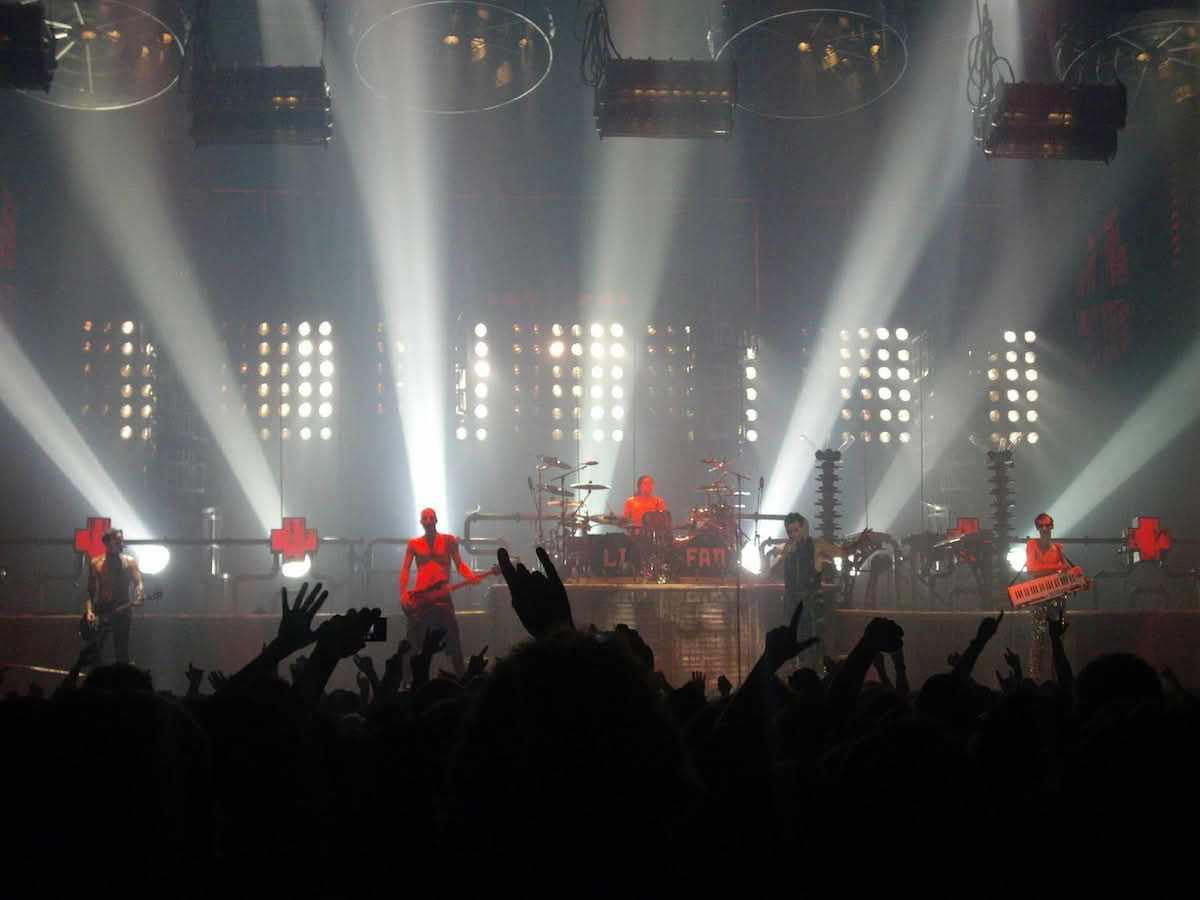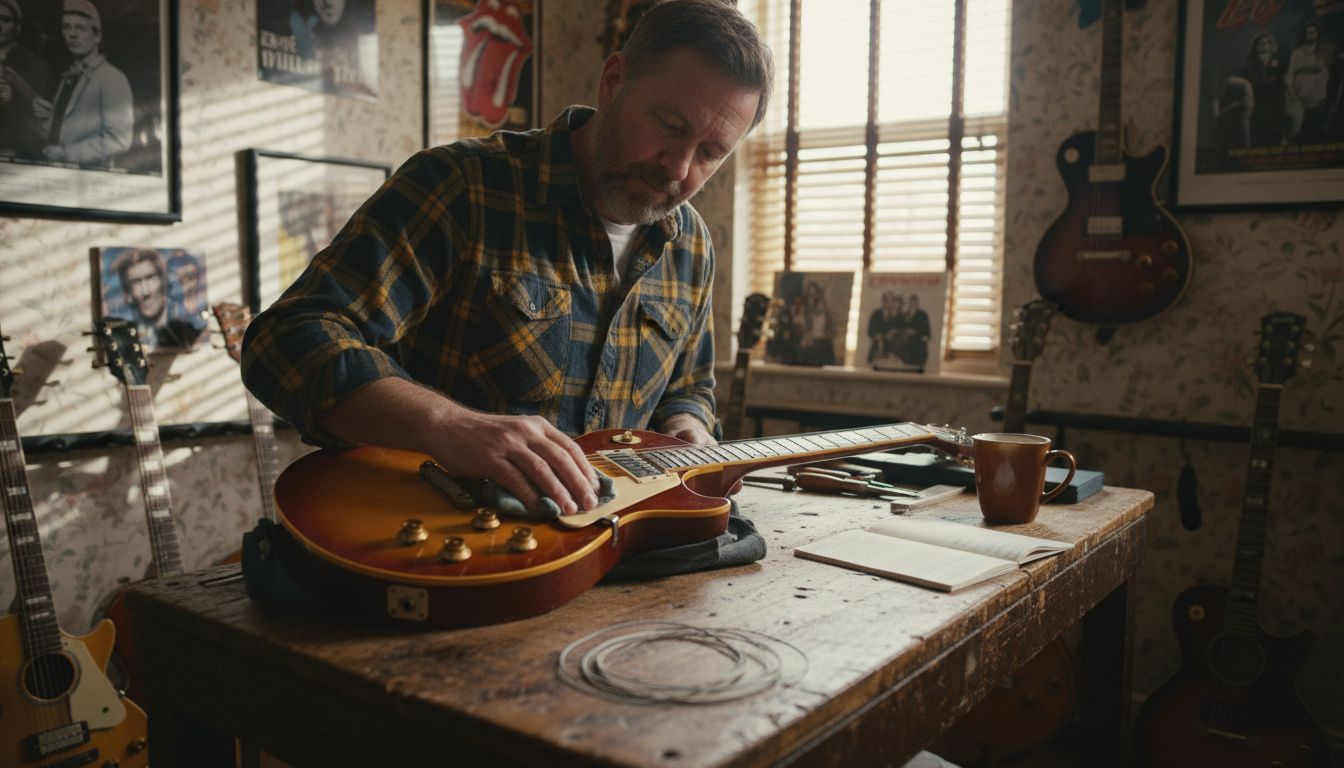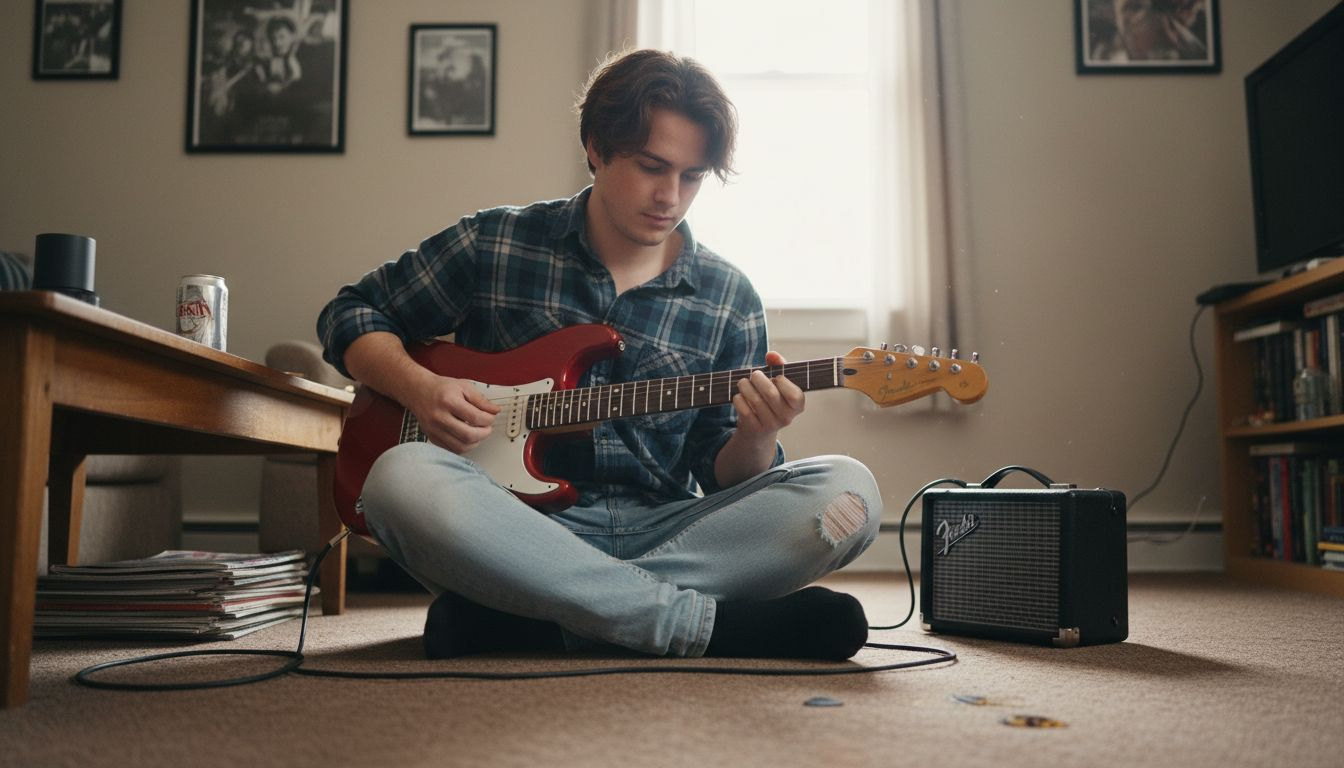If there's one sound that jolts you awake like a blast of pyrotechnics, it's Rammstein—the German industrial metal band whose riffs and relentlessness have helped define the genre for decades. Their music is more than just heavy; it's an engine of drama powered by thunderous guitars, machine-precise rhythms, and unmistakable approach to tone. Want to channel this intensity in your own playing? Whether you’re tackling classics like “Du Hast” or forging your own metallic signature, dive into this deeply detailed guide for not just the spirit, but the specific gear and techniques to play—and sound—like Rammstein.[1]
The Rammstein Guitar Arsenal
Signature Guitars: ESP, Gibson, and More
Richard Zven Kruspe and Paul Landers are as meticulous about their gear as their music. Their weapon of choice is usually an ESP, but the details run much deeper.[2][3]
Richard Zven Kruspe:
- ESP RZK-I, RZK-II, Eclipse, KH-2
Richard’s arsenal includes multiple ESP models: his own signature Burnt series, the classic Eclipse, and the famous KH-2 Kirk Hammett model for drop-tuned brutality. These guitars feature alder or mahogany bodies for balance between attack and warmth, and active EMG 81 (or DiMarzio D Activator in rare cases) humbuckers for fierce, clear output even when running through extreme gain. The Floyd Rose bridge found on some models is essential for deep vibrato and precise intonation.[1][2] - ESP 901: His early career guitar, modded over time with different pickups like Seymour Duncan SH-4 and EMG 81s, showing how experimentation is part of his process.[2]
Paul Landers:
- ESP Eclipse, Les Paul Studio/Custom, Tech 21 PL1 Fly Rig
Paul also swears by ESP, but has embraced Gibson Les Paul Custom and his Tech 21 PL1 Fly Rig signature pedalboard for live flexibility. EMG 60 Active Ceramic Humbucker pickups are his usual choice—fantastic for handling high gain without muddiness.[3] - Fractal Axe-Fx II for digital flexibility and Soldano Avenger Amp heads for main riff power, paired sometimes with a Roland Jazz Chorus for sparkling clean tones in select tracks.[3]
Choosing a Guitar: Finding Your Weapon
If ESP or Gibson isn’t within reach, any hardtail or Floyd Rose-equipped electric fitted with hot humbuckers will get you 90% of the way there. Prioritize the following:
- Solid, heavy body (alder, mahogany, or even basswood) for a thick, punchy sound.[1]
- Active pickups (EMG 81, Seymour Duncan Blackout, DiMarzio D Activator) to prevent your sound from getting lost in the mix.[2][1]
- Tight, stable hardware that handles rigorous down-tuning without intonation issues.
A fixed bridge is best for durability and stable tuning, unless you’re craving wild whammy action; then a Floyd Rose is mandatory.
Acoustic and Studio Guitars
Though rare live, a jumbo acoustic (Gibson J200 style) has appeared in studio tracks for atmospheric sections. These offer shimmering cleans with deep resonance if you want to emulate their softer intros.[3]
Amp Settings and Tone Shaping
The Heart of the Sound: High-Gain Heads
The amp section is where the Rammstein magic really springs forth. The band relies on gear that can produce huge gains without excess mud.
Classic Rammstein Amp Choices:
- Mesa/Boogie Dual and Triple Rectifier:
Seen on almost every major Rammstein tour and studio session. Tube gain, massive low-end, crisp highs, and a mid scoop that remains musical–the very definition of metal rhythm. - Friedman, Bogner Uberschall, ENGL Powerball:
Vintage tube heads (Friedman, Soldano, Bogner) for punchy, organic rhythm, and ENGL Powerball for sheer savagery—even more gain, even tighter response.[2]
Paul Landers’ Setup:
- Soldano Avenger Head, Tech 21 SansAmp GT2 engine, Fractal Axe-Fx II:
Paul seeks amp heads with rapid response for the “Feuer” channel, while clean sections may employ emulation of Roland Jazz Chorus for extra clarity and sparkle.[3]
Digital Modeling and Profiling
On tour and in the studio, both guitarists rely on Kemper Profilers and Fractal Axe-Fx units to preserve their tone night after night. These devices allow them to model classic amp heads and switch sounds seamlessly during performances.[3]
Amp Settings: Getting the Core Rammstein Sound
Here are the general settings to aim for (adjust for your specific gear):
- Gain: 7-8 (aggressive but defined)
- Bass: 6-7 (thick, full low-end, but don’t let it overwhelm)
- Mids: 3-4 (scooped for industrial power, adjusted to taste)
- Treble: 6-7 (enough to cut without excess fizz)
- Presence: 5 (adds clarity and sparkle)
Experiment, but always seek that wall-of-sound clarity—each riff should punch through crisply even when drenched in distortion.[4][1]
If using a modeler or plugin, select a “Rectifier”, “Uberschall”, or “Powerball” preset. These capture the gain structure, bass punch, and mid scoop Rammstein depend on.[1]
Pedals and Effects: Subtle Yet Effective
Rammstein’s pedalboard is far less crowded than most metal guitarists—so keep it simple and direct.
Overdrive/Boost
An overdrive like the Ibanez Tube Screamer or Maxon OD808 is a secret weapon, used as a boost into the front of the amp. Set drive low, level high—tightens low-end, adds bite, and enhances pick attack without overshadowing the amp’s character.[1]
Noise Gate
Massive gain means massive hiss if uncontrolled. The Boss NS-2 and ISP Decimator are favorites among metal bands for slamming shut the gate on hum and feedback. Always place this after your distortion chain.[1]
Chorus
Chorus is a gentle but powerful effect in Rammstein’s palette, adding shimmering width and subtle movement to clean and layered sections. TC Electronic and Carl Martin are trusted brands—keep the depth and mix modest to avoid soapiness.[2]
Delay & Modulation
Used lightly for ambient build-up, especially during intros or breakdowns. Make sure delay times are short, and feedback is minimal; the goal is to add space, not wash out the sound.
Compression
Most live compression is managed via amps or digital modelers, but a pedal compressor (MXR Dyna Comp, Keeley Compressor) can help ensure even volume during fast riffing or palm-muted runs.
Tech 21 PL1 Fly Rig (Paul’s Signature)
Paul Landers uses a custom Tech 21 Fly Rig, which consolidates SansAmp GT2 amp emulation, Roland Jazz Chorus-style cleans, and bite/compression switches for easy stage or studio manipulation. This is a great solution if you want versatile tone with minimal gear.[3]
Strings, Tunings, and Setup: Metal Foundations
String Gauge and Material
Rammstein tunes down—sometimes radically. That means heavy strings:
- .010-.052 or .011-.056 sets give fullness and stability when tuned to Drop D or Drop C.[3]
- Nickel wound or stainless steel both work, but nickel offers the balanced tone most associated with their records.
Paul Landers uses Gibson Brite Wires Electric Guitar Strings on his Les Paul Studio Ebony for extra punch.[3]
Tuning
- Drop C (C-G-C-F-A-D)
Rammstein’s most common tuning—massive, rumbling, still easy to finger. - Drop D (D-A-D-G-B-E)
Used throughout their discography—gives thickness to every riff, and easy transitions for power chords.
Some tracks resort to standard E, but if you want the true Rammstein feel, tune down and beef up those strings.
Setup Tips
- Low, stable action without buzz aids rapid picking and tight muting.
- Careful neck relief—too much bow and you’ll lose definition; too little and strings may choke during heavy riffing.
Regularly check intonation and try to set up at least one guitar dedicated to your rig’s main tuning.
Guitar Techniques: Precision and Power
Palm Muting: The Sonic “Chug”
Palm muting is the beating heart of Rammstein’s tone. To achieve that machine-like “chug”:
- Rest your picking hand gently but firmly on strings near the bridge. Experiment: closer to the bridge means brighter, less mute; farther means duller, heavier mute.[1]
- Pick forcefully but evenly. Don’t hit too hard (muddy), too light (thin); practice a balanced, percussive strike.
- Practice against a drum track or metronome to sync perfectly—precision is everything.
Alternate and Down Picking
Most riffs demand tight, consistent alternate picking—sometimes downpicked entire riffs for relentless drive (as in “Du Hast”).[5][1]
- Small, economical movements.
- Keep pick angle consistent.
- Work out with a metronome to increase speed over time.
Power Chords, Single Notes, and Fingerings
Rammstein riff writing often revolves around simple power chord shapes (root + fifth; sometimes adding the octave), moved across the neck for different feel and color.
- Practice seamless position shifts: No excess finger or string noise.
- Mix in single note accents: Used for hooks and melody in tracks like “Sonne”—clean articulation is key.[6]
Syncopation, Silence, and Song Structure
- Silence is explosive—learn to instantly mute strings for dramatic stops as used in “Du Hast” and “Links 2-3-4”.
- Syncopate rhythms to create tension or drive, especially for breakdowns or chorus buildups.
- Repeat motifs: Rammstein’s music is built on repetition, which gives it hypnotic weight. Don’t be afraid to lock onto a riff and ride it for entire verses.
Clean Arpeggios
For intros and softer moments (“Engel,” “Seemann”), arpeggiate chords cleanly. Use light chorus or modulation for width, and pick more gently for fluidity.
Double Tracking in Studio
In studio recording, repeat every rhythm part, tracking it again and panning hard left and right for enormous stereo presence. Both takes must be near-perfectly timed and tight for authentic sound.[1]
Song Riff Breakdowns: Learn by Example
Let’s go deeper into a few classic tracks to kickstart your Rammstein journey:
“Du Hast”
- Tuning: E Standard or Drop D
- Main Techniques: Heavy palm muting, downpicked power chords, abrupt muting for stops
- Breakdown: Play the fifth fret power chord (577), mute instantly after striking, develop hand stamina for relentless riff repetition.[5]
“Sonne”
- Tuning: Drop C
- Main Techniques: Alternating muted “chug” with ringing open chords, clean transitions between sections.
- Breakdown: Lay into muted rhythms, then release for bold, open chords; keep pick attack even and sync every change with the kick drum for maximum punch.
“Mein Teil” / “Feuer Frei!”
- Tuning: Usually Drop C or D
- Main Techniques: Fast palm mutes, flashy alternate picking, controlled feedback.
- Breakdown: Insert pinch harmonics as punctuation, keep notes precise at faster tempos, and leverage effects sparsely.
“Engel” (Clean Intro/Bridge)
- Tuning: Standard E
- Techniques: Careful arpeggio picking, slow chorus effect, gentle compression.
- Breakdown: Pluck each note evenly; avoid excess background noise or overtone—clean and clear is key.
Tone Tweaks for Bedroom & Studio
Modeling Amps & Plugins
If budget or volume controls your rig:
- Modelers like Kemper, Fractal Axe-Fx, Line 6 Helix can evoke those high-gain legends at quieter, practical levels.
- Look for “Rectifier,” “Uberschall,” or “ENGL Powerball” factory tones.
- Add virtual pedals: Overdrive, chorus, noise gate for polish.
Recording Tips
- Always double track—two takes, panned hard left and right.
- Layer short, subtle delay or reverb for sense of space, especially in leads or intros.
Practice Tips & Playing Mindset
- Focus on repetition, tight phrasing, and channeling energy into each riff.
- Don’t overcomplicate—Rammstein builds drama through simplicity and relentless groove.
- Play with confidence, as if every note is part of a stadium show.
Stage Presence and Performance Attitude
Rammstein are renowned not just for vicious riffing, but for their sheer physical presence and theatrical intensity.
- Stand tall, own the stage: Posture is part of your sound.
- Sync with the drums and bass—Rammstein guitarists act like a single engine, driving the band as one.
- Use silence as part of your performance: Sudden stops, dynamic shifts build anticipation, especially live.
Key Takeaways: Your Personal Industrial Sound
Becoming part of that Rammstein legacy is all about bold choices—selecting the right gear, dialing in monumental tones, and playing with unstoppable confidence.
REMEMBER:
- High-output humbuckers in a solid-body guitar, tuned low, played loud.
- Mesa/Boogie Rectifiers, ENGL Powerballs, and Soldano Avenger heads—or their digital counterparts.
- Skim the pedalboard; focus on overdrive, chorus, and noise gating for polish.
- Tune down, string up with heavy gauges, and keep your setup stable.
- Practice relentless palm muting, precise picking, and boldly repeated riffs.
- Own your performance—drama counts as much as musical precision.
Where to Get Your Gear
Ready to ignite your guitar journey with the spirit and power of Rammstein? Explore the vast selection of signature guitars, killer amps, effects, and more at www.musicstreet.co.uk—the friendly, expert shop where the next great industrial guitarist begins. Get personalized advice, try out the gear, and join a community obsessed with killer tone and unforgettable riffs.
Play tight, play heavy, and don’t be afraid to shake the ground. Willkommen in der Welt von Rammstein!




Share:
Top 10 best songs to play on an acoustic guitar
Guitar Playing Styles: The Definitive Guide to Techniques, Genres, and Mastery